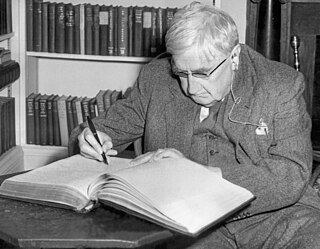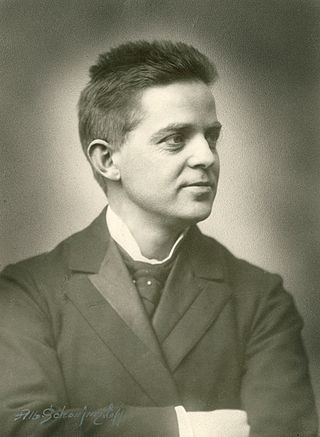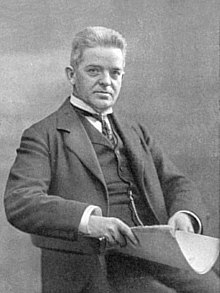
A symphony is an extended musical composition in Western classical music, most often for orchestra. Although the term has had many meanings from its origins in the ancient Greek era, by the late 18th century the word had taken on the meaning common today: a work usually consisting of multiple distinct sections or movements, often four, with the first movement in sonata form. Symphonies are almost always scored for an orchestra consisting of a string section, brass, woodwind, and percussion instruments which altogether number about 30 to 100 musicians. Symphonies are notated in a musical score, which contains all the instrument parts. Orchestral musicians play from parts which contain just the notated music for their own instrument. Some symphonies also contain vocal parts.

Carl August Nielsen was a Danish composer, conductor, and violinist, widely recognized as his country's most prominent composer.
Robert Wilfred Levick Simpson was an English composer, as well as a long-serving BBC producer and broadcaster.
Symphony No. 12 in D minor, Op. 112, subtitled The Year 1917, was composed by Dmitri Shostakovich in 1961. He dedicated it to the memory of Vladimir Lenin. Although the performance on October 1, 1961, by the Leningrad Philharmonic Orchestra conducted by Yevgeny Mravinsky was billed as the official premiere, the actual first performance took place two hours earlier that same day in Kuybyshev by the Kuybyshev State Philharmonic Orchestra conducted by Abram Stasevich.
Carl Nielsen's Concerto for Clarinet and orchestra, op. 57 [D.F.129] was written for Danish clarinetist Aage Oxenvad in 1928. The concerto is presented in one long movement, with four distinct theme groups.
Symphony No. 6 "Sinfonia semplice", FS 116, was Danish composer Carl Nielsen's last symphony.
The Young Person's Guide to the Orchestra, Op. 34, is a 1945 musical composition by Benjamin Britten with a subtitle Variations and Fugue on a Theme of Purcell. It was based on the second movement, "Rondeau", of the Abdelazer suite. It was originally commissioned for the British educational documentary film called Instruments of the Orchestra released on 29 November 1946, directed by Muir Mathieson and featuring the London Symphony Orchestra conducted by Malcolm Sargent; Sargent also conducted the concert première on 15 October 1946 with the Liverpool Philharmonic in the Philharmonic Hall, Liverpool, England.
Symphony No. 4, Op. 29, FS 76, also known as "The Inextinguishable", was completed by Danish composer Carl Nielsen in 1916. Composed against the backdrop of World War I, this symphony is among the most dramatic that Nielsen wrote, featuring a "battle" between two sets of timpani.
Symphonic Metamorphosis of Themes by Carl Maria von Weber is an orchestral work written by German composer Paul Hindemith in the United States in 1943.

Alexander Nevsky is the score composed by Sergei Prokofiev for Sergei Eisenstein's 1938 film Alexander Nevsky. The subject of the film is the 13th century incursion of the knights of the Livonian Order into the territory of the Novgorod Republic, their capture of the city of Pskov, the summoning of Prince Alexander Nevsky to the defense of Rus', and his subsequent victory over the crusaders in 1242. The majority of the score's song texts were written by the poet Vladimir Lugovskoy.

Ralph Vaughan Williams's Symphony No. 8 in D minor was composed between 1953 and 1955. Sir John Barbirolli, its dedicatee, conducted the Hallé Orchestra in the premiere at the Kings Hall in Manchester, on 2 May 1956. It is the shortest of the composer's nine symphonies, and is mostly buoyant and optimistic in tone.

The Symphony No. 3 in C major, Op. 52, is a three-movement work for orchestra written from 1904 to 1907 by the Finnish composer Jean Sibelius.

The Danish composer Carl Nielsen wrote his Symphony No. 3 "Sinfonia Espansiva", Op. 27, FS 60, between 1910 and 1911. Around 35 minutes in length, it is unique in his symphonic output for having vocal parts, specifically wordless solos for soprano and baritone in the second movement.
Erik Oluf Tuxen was a Danish big band leader, composer and arranger, who worked for most of his life in Denmark. From 1936 until his death by cancer on 28 August 1957 he was conductor at the Danish National Symphony Orchestra of Danish Radio.
Symphony No. 1 in G minor, Op. 7, FS 16, is the first symphony of Danish composer Carl Nielsen. Written between 1891 and 1892, it was dedicated to his wife, Anne Marie Carl-Nielsen. The work's première, on 14 March 1894, was performed by Johan Svendsen conducting the Chapel Royal Orchestra, with Nielsen himself among the second violins. It is one of two symphonies by Nielsen without a subtitle.
Symphony No. 2De fire Temperamenter, Op. 16, FS 29, is the second symphony by Danish composer Carl Nielsen, written in 1901–1902 and dedicated to Ferruccio Busoni. It was first performed on 1 December 1902 for the Danish Concert Association, with Nielsen himself conducting. As indicated in the subtitle, each of its four movements is a musical sketch of a humor of the four temperaments: choleric, phlegmatic, melancholic, and sanguine. Despite its apparent concept of program music, the work is a fully integrated symphony in traditional symphonic structure.
The Symphony No. 3 by Arnold Bax was completed in 1929. It was dedicated to Sir Henry Wood and is perhaps the most performed and most immediately approachable of Bax's symphonies.

The Helios Overture, Op. 17, is a concert overture for orchestra written in 1903 by the Danish composer Carl Nielsen. The piece received its premiere at the Odd Fellows Mansion in Copenhagen on 8 October 1903, with Johan Svendsen conducting the Royal Danish Orchestra.

Pan and Syrinx, Op. 49, is a symphonic poem for orchestra written from 1917 to 1918 by the Danish composer Carl Nielsen. The piece received its premiere at the Odd Fellows Mansion in Copenhagen on 11 February 1918, with Nielsen conducting Orchestra of the Music Society.












